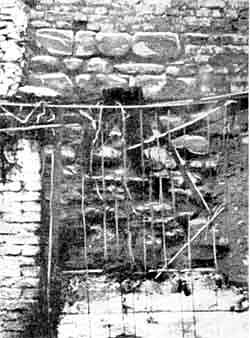< Previous | Contents | Next >
Cave chambers, Bridlesmith-gate
 |
A CURIOUS piece of ancient walling off Cave Chambers, Bridlesmith-gate is usually described as a piece of the old town wall of Nottingham.
In spite of the evident antiquity of this fragment it is very difficult to accept this dictum as being accurate, for if it be true it would make this wall over a thousand years old, instead of which it is probably only about four or five hundred years since it was erected.
There are two periods of fortification in Nottingham’s long history and nobody knows how many more fortifications existed before history took the place of legend and tradition. In 926 Edward the Elder, Alfred the Great’s warlike son, captured Nottingham from the Danes. He built a bridge across the Trent and fortified the town.
The lines of his defences run, more or less along Bridlesmith-gate, Victoria-street, Goose-gate, Hockley, Fisher-gate, Hollow Stone, High Pavement, and Middle Pavement. The market of this little town was at Weekday Cross, and the church stood on the site of St. Mary’s.
That was all there was of Nottingham till the Conquest.
After the establishment of Nottingham Castle the French followers of Peveril settled in a suburb round the Castle which became known as the French Borough, and was ruled under different laws to those which obtained in the older or English Borough. The whole town was burnt in 1141 during King Stephen’s awful reign, and when Henry II. came to the throne in 1154 he encouraged the townsfolk to build another and much more extensive fortification than the Edward the Elder defence.
Starting at Postern-street, the line of this defence is roughly down Park-row, Parliament-street, St. John’s-street, Count-street, Carter-gate, Fisher-gate, Hollow Stone, High, Middle and Low Pavement, Lister-gate, Walnut Tree-lane.
The problem is to fit this piece of ancient walling into either of these fortifications.
